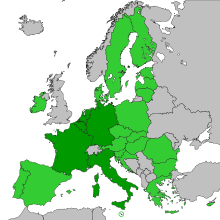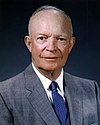
Nuclear proliferation is the spread of nuclear weapons, fissionable material, and weapons-applicable nuclear technology and information to nations not recognized as "Nuclear Weapon States" by the Treaty on the Non-Proliferation of Nuclear Weapons, commonly known as the Non-Proliferation Treaty or NPT. Proliferation has been opposed by many nations with and without nuclear weapons, as governments fear that more countries with nuclear weapons will increase the possibility of nuclear warfare, de-stabilize international or regional relations, or infringe upon the national sovereignty of nation states.

The European Atomic Energy Community is an international organisation established by the Euratom Treaty on 25 March 1957 with the original purpose of creating a specialist market for nuclear power in Europe, by developing nuclear energy and distributing it to its member states while selling the surplus to non-member states. However, over the years its scope has been considerably increased to cover a large variety of areas associated with nuclear power and ionising radiation as diverse as safeguarding of nuclear materials, radiation protection and construction of the International Fusion Reactor ITER.

The Savannah River Site (SRS) is a U.S. Department of Energy (DOE) reservation in the United States, located in the state of South Carolina on land in Aiken, Allendale, and Barnwell counties adjacent to the Savannah River. It lies 25 miles (40 km) southeast of Augusta, Georgia. The site was built during the 1950s to refine nuclear materials for deployment in nuclear weapons. It covers 310 square miles (800 km2) and employs more than 10,000 people.
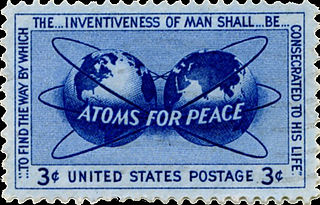
"Atoms for Peace" was the title of a speech delivered by U.S. President Dwight D. Eisenhower to the UN General Assembly in New York City on December 8, 1953.
I feel impelled to speak today in a language that in a sense is new—one which I, who have spent so much of my life in the military profession, would have preferred never to use. That new language is the language of atomic warfare.

The US–UK Mutual Defense Agreement, or 1958 UK–US Mutual Defence Agreement, is a bilateral treaty between the United States and the United Kingdom on nuclear weapons co-operation. The treaty's full name is Agreement between the Government of the United States of America and the Government of the United Kingdom of Great Britain and Northern Ireland for Cooperation on the uses of Atomic Energy for Mutual Defense Purposes. It allows the US and the UK to exchange nuclear materials, technology and information. The US has nuclear co-operation agreements with other countries, including France and other NATO countries, but this agreement is by far the most comprehensive. Because of the agreement's strategic value to Britain, Harold Macmillan called it "the Great Prize".
A nuclear fuel bank is reserve of low enriched uranium (LEU) for countries that need a backup source of LEU to fuel their nuclear reactors. Countries that do have enrichment technology would donate enriched fuel to a "bank", from which countries not possessing enrichment technology would obtain fuel for their power reactors.
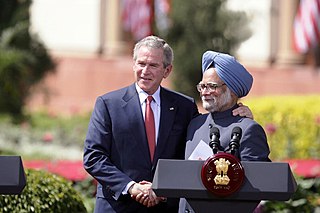
The 123 Agreement signed between the United States of America and the Republic of India is known as the U.S.–India Civil Nuclear Agreement or Indo-US nuclear deal. The framework for this agreement was a July 18, 2005, joint statement by then Indian Prime Minister Manmohan Singh and then U.S. President George W. Bush, under which India agreed to separate its civil and military nuclear facilities and to place all its civil nuclear facilities under International Atomic Energy Agency (IAEA) safeguards and, in exchange, the United States agreed to work toward full civil nuclear cooperation with India. This U.S.-India deal took more than three years to come to fruition as it had to go through several complex stages, including amendment of U.S. domestic law, especially the Atomic Energy Act of 1954, a civil-military nuclear Separation Plan in India, an India-IAEA safeguards (inspections) agreement and the grant of an exemption for India by the Nuclear Suppliers Group, an export-control cartel that had been formed mainly in response to India's first nuclear test in 1974. In its final shape, the deal places under permanent safeguards those nuclear facilities that India has identified as "civil" and permits broad civil nuclear cooperation, while excluding the transfer of "sensitive" equipment and technologies, including civil enrichment and reprocessing items even under IAEA safeguards. On August 18, 2008, the IAEA Board of Governors approved, and on February 2, 2009, India signed an India-specific safeguards agreement with the IAEA. After India brought this agreement into force, inspections began in a phased manner on the 35 civilian nuclear installations India has identified in its Separation Plan. The deal is seen as a watershed in U.S.-India relations and introduces a new aspect to international nonproliferation efforts. On August 1, 2008, the IAEA approved the safeguards agreement with India, after which the United States approached the Nuclear Suppliers Group (NSG) to grant a waiver to India to commence civilian nuclear trade. The 48-nation NSG granted the waiver to India on September 6, 2008, allowing it to access civilian nuclear technology and fuel from other countries. The implementation of this waiver made India the only known country with nuclear weapons which is not a party to the Non-Proliferation Treaty (NPT) but is still allowed to carry out nuclear commerce with the rest of the world.
As of 2022, nuclear power is provided by six commercial nuclear power plants in Pakistan. Pakistan is the first Muslim majority country in the world to construct and operate civil nuclear power plants. The Pakistan Atomic Energy Commission (PAEC), the scientific and nuclear governmental agency, is solely responsible for operating these power plants. As of 2018, the electricity generated by commercial nuclear power plants constitutes roughly 7.5% of electricity generated in Pakistan, Pakistan is not a party to the Nuclear Non-Proliferation Treaty but is a member of the International Atomic Energy Agency. Pakistan plans on constructing 32 nuclear power plants by 2050 and envisions 40,000 MW of nuclear power generation.
Material Protection, Control, and Accounting (MPC&A) refers to the safeguarding of nuclear assets, including nuclear fuel and weapons. In the United States, the National Nuclear Security Administration (NNSA), a component of the Department of Energy, oversees MPC&A as part of its nonproliferation program.
This is the timeline of the nuclear program of Iran.
Nuclear power is the fifth-largest source of electricity in India after coal, gas, hydroelectricity and wind power. As of November 2020, India has 22 nuclear reactors in operation in 8 nuclear power plants, with a total installed capacity of 7,380 MW. Nuclear power produced a total of 43 TWh in 2020–21, contributing 3.11% of total power generation in India. 10 more reactors are under construction with a combined generation capacity of 8,000 MW.
Nuclear power in the European Union accounted for approximately 26% of total electricity production in 2019 and nearly half of low-carbon energy production across the EU.

Fusion for Energy(F4E) is a joint undertaking of the European Atomic Energy Community (Euratom) that is responsible for the EU's contribution to the International Thermonuclear Experimental Reactor (ITER), the world's largest scientific partnership aiming to demonstrate fusion as a viable and sustainable source of energy. The organisation is officially named European Joint Undertaking for ITER and the Development of Fusion Energy and was created under article 45 of the Treaty establishing the European Atomic Energy Community by the decision of the Council of the European Union on 27 March 2007 for a period of 35 years.

The Pakistan Atomic Research Reactor or (PARR) are two nuclear research reactors and two other experimental neutron sources located in the PINSTECH Laboratory, Nilore, Islamabad, Pakistan.
Nuclear energy is used in Slovenia for a number of civilian purposes including electricity production, medicine, and research.

Nuclear Non-Proliferation Act of 1978, 22 U.S.C. § 3201, is a United States federal law declaring that nuclear explosive devices pose a perilous threat to the security interests of the United States and continued international progress towards world peace and the development of nations.
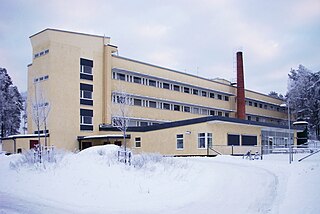
After World War II, Sweden considered building nuclear weapons to defend themselves against an offensive assault from the Soviet Union. From 1945 to 1972 the government ran a clandestine nuclear weapons program under the guise of civilian defense research at the Swedish National Defence Research Institute (FOA).

Nuclear Safety, Research, Demonstration, and Development Act of 1980, 42 U.S.C. § 9701, established nuclear safety policy for nuclear power plants supplying electric energy and electricity generation within the United States. The Act authorized a five-year demonstration program simulating conditions with light water nuclear reactors for the observation of control monitoring and phases of operation for nuclear reactor cores. The U.S. Department of Energy was authorized by the Act of Congress to conduct the nuclear reactor demonstration study while establishing a reactor engineering simulator facility at a United States national laboratory. The nuclear safety demonstration program was to provide research data regarding reactor design and simplification improvements given thermal power station simulations subjecting nuclear reactors to hypothesized calamity and customary operating conditions.

The EU–UK Trade and Cooperation Agreement (TCA) is a free trade agreement signed on 30 December 2020, between the European Union (EU), the European Atomic Energy Community (Euratom), and the United Kingdom (UK). It provisionally applied from 1 January 2021, when the Brexit transition period ended, before formally entering into force on 1 May 2021, after the ratification processes on both sides were completed: the UK Parliament ratified on 30 December 2020; the European Parliament and the Council of the European Union ratified in late April 2021.
Material unaccounted for (MUF), in the context of nuclear material, refers to any discrepancy between a nuclear-weapons state's physical inventory of nuclear material, and the book inventory. The difference can be either a positive discrepancy or a negative discrepancy. Nuclear accounting discrepancies are commonplace and inevitable due to the problem of accurately measuring nuclear materials. This problem of inaccurate measurement provides a potential loophole for diversion of nuclear materials for weapons production. In a large plant, even a tiny percentage of the annual through-put of nuclear material will suffice to build one or more nuclear weapons.

